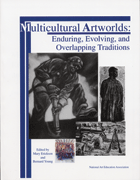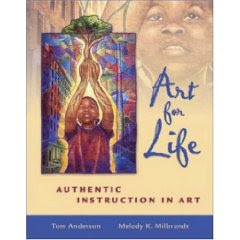Postmodern Principles: 7 + 7?
By Olivia Gude
JANUARY 2004 / ART EDUCATION
“’According to a recent NAEA survey, teaching understanding of the elements and principles of design is the major curriculum goal [emphasis added] for art teachers at the beginning of the 21st century’ (SchoolArts, 2001).”
“When visiting K-12 school art programs, I rarely see meaningful connections being made between these formal descriptors and understanding works of art or analyzing the quality of everyday design”
“I wonder why what is still considered by many to be the appropriate organizing content for the foundations of 21st century art curriculum is but a shadow of what was modem, fresh, and inspirational 100 years ago.”
“These elements and principles are proffered as universal and foundational.”
“In a number of classic modernist texts about teaching art…There is no single, agreed-upon set of terms or constituent elements of the visual in these books. Instead, various structures of organization are proposed with different emphases, principles, and suggested areas for investigation.”
“Whether embodying the graceful dignity of an Arts and Crafts sensibility, idiosyncratic early modernism, or hip sixties chic, the student examples in these works differ greatly from the listless lines and uninteresting color schemes resulting from contemporary textbook art exercises. Many of these modernist texts also differ sharply from their deracinated contemporary cousins in that they contain culturally specific aesthetic references”
“The artworks are viewed and understood using the streamlined 7 + 7 Euro-American system of describing form, therefore students often do not learn the aesthetic context of making and valuing inherent to the artists and communities who actually created the works.”
“This ungrounded and highly problematic use of the art of "others" is almost inevitable in classrooms that use 7 + 7 concepts as a foundational curriculum structure because the modernist philosophy of elements and principles privileges formalist Western conceptions over other ways to value and understand art…this only succeeds in modeling for students that the art of other cultures can be ahistorically appropriated for current uses of Western, ostensibly neutral, educational and aesthetic systems.”
“Today discussions of the meaning of art, including modern and contemporary abstract art, are more likely to center on the context within which the art was made and seen and the cultural codes the artist chooses to reference and manipulate (Riemschneider & Grosenick, 1999).”
“We owe it to our field and our students to study the art of our times and to begin, as Dow did, with probing questions and, far reaching goals.”
Founding Principles of the Spiral Workshops (the University of Illinois at Chicago's Saturday art classes for teens)
“Students in a quality art education program gain the capacity to reflect on cultural issues related to self and society.”
“Spiral Workshop evolved three criteria for our curriculum:
* curriculum based on generative themes that relate to the lives of students and their communities;
* studio art projects based on diverse practices of contemporary artmaking and related traditional arts;
* art as investigation-understanding the art of others and seeing their own artmaking, not as exercises, but as research that produces new visual and conceptual insights.”
After reflecting on the work of the Spiral Workshops and Contemporary Community Curriculum Initiative (CCCI)
“A common vocabulary could be used to describe various visual and conceptual strategies in the students' artworks and in the contemporary professional artworks on which they were modeled. I also noticed that the traditional 7 + 7 elements and principles vocabulary could not adequately describe these artworks.”
“I identified 15 categories or principles that described the students' artwork…I have since edited and consolidated the list to highlight eight important postmodern artmaking practices”
“They (the postmodern artmaking practices) are hybrids of the visual and the conceptual.”
Appropriation
“The student artwork often used print materials as the stuff out of which their art was composed.”
“If one lives in a forest, wood will likely become one's medium for creative play. If one grows up in a world filled with cheap, disposable images, they easily become the stuff of one's own creative expression.”
Juxtaposition
“The term juxtaposition is useful in helping students discuss the familiar shocks of contemporary life in which images and objects from various realms and sensibilities come together as intentional clashes or random happenings.”
Recontextualization
“Often, positioning a familiar image in relationship to pictures, symbols, or texts with which it is not usually associated generates meaning in an artwork”
Layering
“As images become cheap and plentiful they are no longer treated as precious, but are often literally piled on top of each other.”
Interaction of Text & Image
“Students who make and value art in the 21st century must learn not to demand a literal match of verbal and visual signifiers, but rather to explore disjuncture between these modes as a source of meaning and pleasure.”
Hybridity
“Many contemporary artists incorporate various media into their pieces, using whatever is required to fully investigate the subject”
“The concept of hybridity also describes the cultural blending evident in many works”
Gazing
“By shifting the context within which a familiar advertising image is seen, students spontaneously question who creates and controls imagery and how this imagery affects our understandings of reality-an important activity of visual culture art education.”
“Gazing, associated with issues of knowledge and pleasure, is also a form of power and of controlling perceptions of what is ‘real’ and ‘natural.’”
Representin’
“U.S. urban street slang for proclaiming one's identity and affiliations, representin' describes the strategy of locating one's artistic voice within one's own history and culture of origin.”
“It is important that art classes provide students with opportunities for meaningful self-expression in which they become representin', self-creating beings. These opportunities should allow students to see examples of contemporary artists using artmaking to explore the potentials and problems inherent in their own cultural and political settings”
A Principled Position on the Future of Art Education
“The elements and principles of design were never the universal and timeless descriptors they were claimed to be. Indeed, they are not even sufficient to introduce students to most modem art”
“Much art education has been associated with what critic Clement Greenberg referred to as "cold modernism" (1971), focused on artists such as Manet, Seurat, Cezanne, Matisse, and Picasso. ”Hot modernism," characterized by artists such as Duchamp and the Dadaists, has not been adequately represented in K-12 art discourses despite the fact that such artists are far more likely to be cited as influential to today's art world.”
“Further curriculum research will no doubt identify other important postmodern concept and practices that ought to be considered for inclusion in contemporary art education curricula.”
“I do not hope to see a generation of art education texts that merely add a few postmodern principles such as juxtaposition and appropriation to their lists of modernist elements and principles and then proceed to use them to structure and justify a curriculum.”
“Postmodern thought embraces the heterogeneous, the local, and the specific. It affirms the choice-making capacity of individuals”
“By structuring art projects to introduce students to relevant contemporary art and thus to postmodern principles-strategies for understanding and making art today-students will gain the skills to participate in and shape contemporary cultural conversations.”





